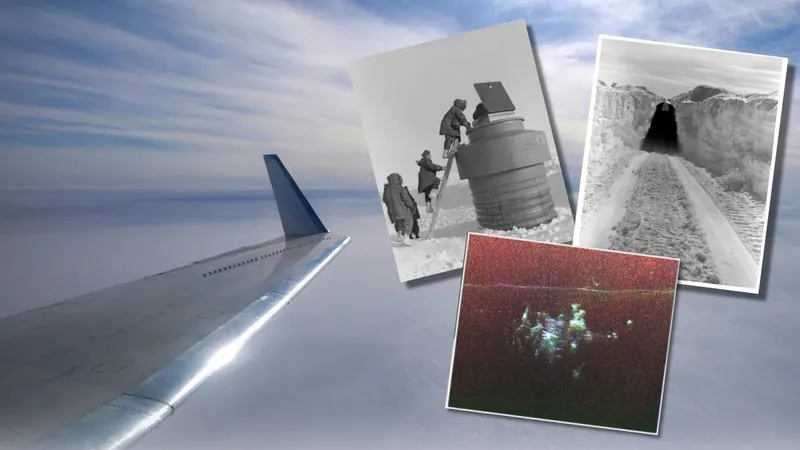
Hidden Beneath the Ice: NASA Discovers Secret Cold War Missile Base in Greenland!
2024-11-25
Author: Ying
NASA's Stunning Discovery
In an astonishing reveal of Cold War secrets, NASA scientists have uncovered remnants of an abandoned U.S. military facility buried beneath the Greenland Ice Sheet, sparking intrigue and concern about the past. During an April 2024 mission, a NASA Gulfstream III aircraft equipped with advanced radar technology flew over the vast icy expanse, generating unprecedented images of what experts are calling a "city under the ice."
Camp Century and Project Iceworm
The NASA flight revealed startling insights into Camp Century, an isolated U.S. military base constructed in the late 1950s. This covert location served as a part of a classified initiative known as Project Iceworm, intended to create an extensive network of tunnels—around 2,500 miles in total—to house nuclear intermediate range ballistic missiles (IRBMs) aimed at the Soviet Union. "We didn't know what it was at first," noted Chad Greene, a cryospheric scientist at NASA's Jet Propulsion Laboratory. "The new data provides visibility into individual structures in the secret city like never before."
The Rise and Fall of Camp Century
Construction at Camp Century began in 1959 but was ultimately abandoned in 1967 due to the escalating costs and the formidable challenge of preventing the tunnels from collapsing under the weight of the shifting ice. The ambition behind Project Iceworm rested on using northern Greenland as a launch pad due to its strategic proximity to the Soviet Union, leveraging the region's remoteness for clandestine military operations.
Environmental Concerns
According to a detailed 2007 analysis published in The Scandinavian Journal of History, the project aimed to create an overarching missile infrastructure consisting of "thousands of miles of cut-and-cover tunnels," designed to shield missiles beneath the ice. The modified Minuteman IRBM, dubbed "Iceman," was envisioned to launch from this treacherous terrain—a feat that was ultimately deemed unfeasible.
A Call to Action
As the ice thaws and climate change accelerates, concerns intensify over the contaminants buried beneath Camp Century—ranging from military waste to hazardous materials. In a proactive stance, the U.S. government acknowledged in 2017 the potential risks posed by climate change and pledged cooperation with Danish authorities regarding the derelict base's legacy.
Significance in Climate Research
The significance of Camp Century extends beyond its military history; it serves as a crucial reference point for monitoring climate change. The data collected from the recent surveys will guide NASA in understanding how melting ice sheets may affect global sea levels. "Without detailed knowledge of ice thickness, it's nearly impossible to predict how these ice sheets will behave in our rapidly warming world," highlighted JPL scientist Alex Gardner.
The Role of Pituffik Space Base
Moreover, the flights that revealed these hidden structures were launched from Pituffik Space Base, formerly known as Thule Air Force Base, which now stands as the U.S. military's northernmost outpost engaged in vital operations related to missile surveillance and defense.
A Reflection of the Cold War’s Legacy
The discovery of Camp Century not only unearths a critical piece of history but also serves as a haunting reminder of the Cold War’s shadow over our present climate challenges. As scientists and historians alike delve deeper into this "city under the ice," they uncover reflections of a time that still influences geopolitics and environmental strategies today. Stay tuned as more revelations surface from beneath the Arctic chill!


 Brasil (PT)
Brasil (PT)
 Canada (EN)
Canada (EN)
 Chile (ES)
Chile (ES)
 España (ES)
España (ES)
 France (FR)
France (FR)
 Hong Kong (EN)
Hong Kong (EN)
 Italia (IT)
Italia (IT)
 日本 (JA)
日本 (JA)
 Magyarország (HU)
Magyarország (HU)
 Norge (NO)
Norge (NO)
 Polska (PL)
Polska (PL)
 Schweiz (DE)
Schweiz (DE)
 Singapore (EN)
Singapore (EN)
 Sverige (SV)
Sverige (SV)
 Suomi (FI)
Suomi (FI)
 Türkiye (TR)
Türkiye (TR)